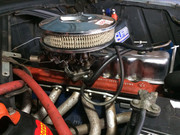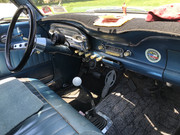Before I have my E0 hex-log head milled, I need to remove the original head to check the deck height and confirm the .030 over bore I remember. I'd like to keep downtime before the new head is installed to a minimum. Depending on what I find, I want to be able to make a choice and follow a plan, and I need to know if my goals are realistic and achievable. I've looked around here a lot, and at other sites, and there are few hard and fast rules that can be simply and safely followed by any old fool, and a lot of conflicting information. Please forgive me for dragging this poor long dead horse from its grave for yet another beating! I suppose I should start with a description of what I have and what I want to do.
I still have my first car, a '66 Mustang convertible with the original 200 and C4. Been driving it 50 years this summer! The engine got a high-quality rebuild at a good shop, balanced and blueprinted, forty five years ago. Since then it has only been driven 25K - 30K miles. It still runs great, very smooth, but is starting to leak a little oil. The factory head is fine, but after this E0 head and a little money fell in my lap I decided to retire the original small-log head before it does wear out or crack. I'm hoping to wind up with about a 9:1 CR with the new head. I'd also like to keep the block in a state where the two heads would be interchangeable, so zero-decking it for a higher compression ratio on the E0 head would probably result in too high a CR with the old head and its small combustion chambers. I'm not sure how much it may have been milled in the long ago rebuild, but I'll be checking that. Plus I'd rather keep the engine in the car for now. After this head swap is fully integrated and it's running good, a full engine pull and refresh is planned for next year maybe. Hopefully all it needs is gaskets and seals, but while it's out all the other you might as wells will get replaced too.
So the most important factor for head interchangeability is my deck height. All my compression ratio calculations (well, the CR calculator's calculations) were made assuming a 3.71 bore and 3.126 stroke, and a Felpro gasket bore of 3.82 and compressed thickness of .050. From what I have seen, though not definitively, an original engine's compression height was about 0.019. Hard to say what mine actually is until I pull the head, but if it is .019 that would yield a 9:1 CR with a 50 cc combustion chamber. I hear new replacement pistons have a lower compression height than original pistons though. I'm not sure if that was the case 45 years ago when my pistons were replaced, or if the engine builder decked the block a bit to keep the dimension stock, as he was "blueprinting" the engine as well as balancing it. Anyway, a 50 cc combustion chamber should be very similar to the original head's volume, so I'm hoping the deck height is no larger.
So, how much can and/or should be milled off the newer E0 head? That's the tricky bit. It has been rebuilt at least once before, and was possibly milled a bit already. I've had new valves, guides, seals, and springs installed already. The old valves looked pretty far down in their seats, and I wanted the new ones in before I did volume measurements. I've measured the two end combustion chamber's volumes a couple times, and got 61 cc in front, and 60 cc in the back one. Accuracy was probably about +/- 1 cc. Just to see where it wound up, with the head level, I squirted 52 cc of fluid in a combustion chamber. Of course, without a cover plate there was a meniscus, but it looked like it would be just about to the bottom of the little lip on the shallow side of the chambers. One thing that concerned me some was that those lips weren't consistent looking from chamber to chamber. The general trend was shallower towards the rear, but only the front one is real noticeably different. Another head I have they are more uniform looking. I'm not sure if that is normal and harmless or a sign that the head was made or milled crooked or something.
One thing in my favor here is that the machine shop will give me two mill cuts for the price of one. I can make one conservative cut, I'm thinking maybe .050", re-measure, and recut for a hopefully very accurate result. But before I start hacking away at my head I'd like to know for sure that reducing the combustion chamber volume in an E0 head down to 50 cc or even a little smaller is possible and safe through milling alone. It looks like the cut might be about .060 or .070 inches or so. Another bit of knowledge I'd like from the wise seers here is if such a cut will mean I need adjustable rockers. It is said by some that the hydraulic lifters will handle that much change. I've got a nice rebuilt non-adjustable rocker shaft assembly I'd like to use if I can. I wouldn't mind putting some washers under the rocker shaft supports if I had to, if that actually works. So there it is, I'd appreciate any advice or insights you people have to offer. Thanks in advance.
I still have my first car, a '66 Mustang convertible with the original 200 and C4. Been driving it 50 years this summer! The engine got a high-quality rebuild at a good shop, balanced and blueprinted, forty five years ago. Since then it has only been driven 25K - 30K miles. It still runs great, very smooth, but is starting to leak a little oil. The factory head is fine, but after this E0 head and a little money fell in my lap I decided to retire the original small-log head before it does wear out or crack. I'm hoping to wind up with about a 9:1 CR with the new head. I'd also like to keep the block in a state where the two heads would be interchangeable, so zero-decking it for a higher compression ratio on the E0 head would probably result in too high a CR with the old head and its small combustion chambers. I'm not sure how much it may have been milled in the long ago rebuild, but I'll be checking that. Plus I'd rather keep the engine in the car for now. After this head swap is fully integrated and it's running good, a full engine pull and refresh is planned for next year maybe. Hopefully all it needs is gaskets and seals, but while it's out all the other you might as wells will get replaced too.
So the most important factor for head interchangeability is my deck height. All my compression ratio calculations (well, the CR calculator's calculations) were made assuming a 3.71 bore and 3.126 stroke, and a Felpro gasket bore of 3.82 and compressed thickness of .050. From what I have seen, though not definitively, an original engine's compression height was about 0.019. Hard to say what mine actually is until I pull the head, but if it is .019 that would yield a 9:1 CR with a 50 cc combustion chamber. I hear new replacement pistons have a lower compression height than original pistons though. I'm not sure if that was the case 45 years ago when my pistons were replaced, or if the engine builder decked the block a bit to keep the dimension stock, as he was "blueprinting" the engine as well as balancing it. Anyway, a 50 cc combustion chamber should be very similar to the original head's volume, so I'm hoping the deck height is no larger.
So, how much can and/or should be milled off the newer E0 head? That's the tricky bit. It has been rebuilt at least once before, and was possibly milled a bit already. I've had new valves, guides, seals, and springs installed already. The old valves looked pretty far down in their seats, and I wanted the new ones in before I did volume measurements. I've measured the two end combustion chamber's volumes a couple times, and got 61 cc in front, and 60 cc in the back one. Accuracy was probably about +/- 1 cc. Just to see where it wound up, with the head level, I squirted 52 cc of fluid in a combustion chamber. Of course, without a cover plate there was a meniscus, but it looked like it would be just about to the bottom of the little lip on the shallow side of the chambers. One thing that concerned me some was that those lips weren't consistent looking from chamber to chamber. The general trend was shallower towards the rear, but only the front one is real noticeably different. Another head I have they are more uniform looking. I'm not sure if that is normal and harmless or a sign that the head was made or milled crooked or something.
One thing in my favor here is that the machine shop will give me two mill cuts for the price of one. I can make one conservative cut, I'm thinking maybe .050", re-measure, and recut for a hopefully very accurate result. But before I start hacking away at my head I'd like to know for sure that reducing the combustion chamber volume in an E0 head down to 50 cc or even a little smaller is possible and safe through milling alone. It looks like the cut might be about .060 or .070 inches or so. Another bit of knowledge I'd like from the wise seers here is if such a cut will mean I need adjustable rockers. It is said by some that the hydraulic lifters will handle that much change. I've got a nice rebuilt non-adjustable rocker shaft assembly I'd like to use if I can. I wouldn't mind putting some washers under the rocker shaft supports if I had to, if that actually works. So there it is, I'd appreciate any advice or insights you people have to offer. Thanks in advance.






